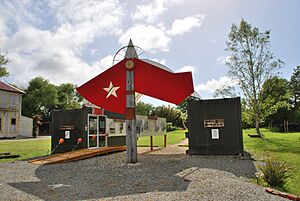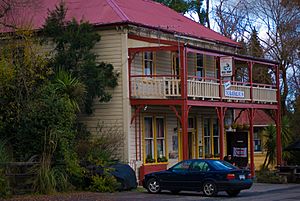Blackball, New Zealand facts for kids
Quick facts for kids
Blackball
|
|
|---|---|

Blackball Miners Strike Memorial
|
|
| Country | New Zealand |
| Region | West Coast |
| District | Grey District |
| Ward | Eastern |
| Electorates |
|
| Area | |
| • Total | 1.94 km2 (0.75 sq mi) |
| Population
(June 2023)
|
|
| • Total | 300 |
| • Density | 155/km2 (400/sq mi) |
| Local iwi | Ngāi Tahu |
Blackball is a small town located on the West Coast of New Zealand's South Island. It's about 29 kilometers (18 miles) from Greymouth. The town sits at an elevation of around 100 meters (328 feet) above sea level.
Blackball is famous for its history of workers standing up for their rights. Many people believe it's where the ideas for the New Zealand Labour Party first began. This happened after the 1908 miners' strike, which lasted ten weeks. It was the longest strike in New Zealand's history at that time.
Miners from Blackball were very determined. During the big 1913 Great Strike, they were the last workers to go back to their jobs in 1914. They strongly supported each other during these tough times. The coal mine in Blackball eventually closed in 1964.
Contents
Discovering Blackball's Past
Blackball's story began with a gold rush in the Moonlight area around 1864-1865. In November 1865, a gold nugget was found in Blackball Creek. More gold was found in 1866, making the area popular. This place was first called Garden Gully, then Croesus.
How Blackball Got Its Name
The town of Blackball was officially founded in 1893. This happened after a coal mine was set up nearby. The town got its name from the Black Ball Shipping Line. This company had rented land in the area to mine for coal.
As more gold miners arrived, it became hard to get them enough food. A spot called The Plateau (which later became Blackball) was used as an overnight stop. It was part of a two-day trip from Greymouth. Soon, small huts and storage sheds appeared, forming the little town we know today.
Community Life in Early Blackball
The Blackball Workingmen's Club is one of the few old community groups still active. In the past, Blackball had many clubs. These included the Oddfellows Lodge and the Buffaloes Lodge. These groups helped people financially and offered ways to learn new things. This was important before TV and government social support existed.
The Oddfellows Hall was a very important place. It was used for many community events and social gatherings. Another group, the United Ancient Order of Druids, started a lodge in Blackball in 1906. Like many old groups, it no longer exists in the town.
The Blackball Lodge No 80 of the Royal Antediluvian Order of Buffaloes opened on June 7, 1941. It was held in the Oddfellows Lodge Hall. The mine closed in 1964, which changed the town a lot.
Bringing Blackball's Heritage Back to Life
Since 2018, the community has been working to restore Blackball's history. They received $1.9 million from the Department of Internal Affairs. This money helps them fix up old sites. They have restored a coal mine chimney and a 5.5-kilometer (3.4-mile) ropeway. This ropeway was once used to carry coal.
Blackball's Population and People
Blackball is considered a rural settlement by Statistics New Zealand. It covers an area of 1.94 square kilometers (0.75 square miles). As of June 2023, it had an estimated population of 300 people. This means there are about 155 people per square kilometer. Blackball is part of the larger Barrytown area for statistics.
Population Changes Over Time
- 2006: 315 people
- 2013: 276 people
- 2018: 273 people
At the 2018 New Zealand census, Blackball had 273 residents. This was a small decrease of 3 people (1.1%) since the 2013 census. It was a larger drop of 42 people (13.3%) since the 2006 census. There were 138 households in the town.
There were 153 males and 126 females, meaning there were about 1.21 males for every female.
- 33 people (12.1%) were under 15 years old.
- 45 people (16.5%) were aged 15 to 29.
- 153 people (56.0%) were aged 30 to 64.
- 51 people (18.7%) were 65 or older.
Who Lives in Blackball?
Most people in Blackball are of European/Pākehā background (94.5%). Other groups include:
- Māori: 12.1%
- Pasifika: 1.1%
- Asian: 2.2%
- Other ethnicities: 2.2%
Some people identify with more than one ethnic group.
When asked about religion, 64.8% said they had no religion. About 18.7% were Christian, and 5.5% followed other religions.
Of those aged 15 and older, 12 people (5.0%) had a university degree or higher. 72 people (30.0%) had no formal qualifications. About 18 people (7.5%) earned over $70,000 a year. This is lower than the national average of 17.2%.
Regarding jobs, 99 people (41.2%) worked full-time. 39 people (16.2%) worked part-time, and 21 people (8.8%) were unemployed.
Blackball's Railway Connection
Blackball was the end point of the New Zealand Railways Department's Blackball Branch line. This was a smaller railway line that connected to the main Stillwater–Westport Line. The railway line was approved in 1901, and building started in 1902. Trains first ran in 1909, and the line officially opened on August 1, 1910.
The Roa Incline and Its Purpose
Private companies built a very steep extension from Blackball into the Paparoa Ranges. This part used a special system called the Fell mountain railway system to help trains brake on the steep slopes. The State Mines Department later took over this extension, calling it the Roa Incline.
Passenger trains ran to Blackball until 1940, mainly for the miners. Coal was the most important cargo for the railway. When less coal was being transported, the Roa Incline closed on July 25, 1960. Trains to Blackball became less frequent.
On February 21, 1966, a flood damaged two parts of the railway bridge over the Grey River. The Railways Department decided it was too expensive to fix, so the line closed. Blackball's train station building had already been destroyed by fire in 1955.
Special Places in Blackball
Blackball is home to several historic sites. These places are officially recognized by Heritage New Zealand.
- The Blackball coal mine chimneys are a very important historical site (Category 1).
- The Blackball mine return air vent and fan chamber are also very important (Category 1).
- "Formerly The Blackball Hilton" is a hotel that had to change its name. The Hilton Hotels & Resorts company asked them to. It is a significant historical place (Category 2).
- The Blackball Community Centre is also a recognized historical site (Category 2).
- The Miners Bath House, where miners could wash up after work, is another important historical building (Category 2).
The Blackball Museum of Working Class History opened in the town on May 1, 2010. Its goal is to celebrate the important role working people have played. It shows how they helped build the country and create society.
Blackball in Books
For a small town, Blackball has appeared in many books.
- Coal Flat: Bill Pearson's novel Coal Flat (1963) is a famous New Zealand book. Pearson taught in Blackball in 1942 and became friends with a local family. His book made some people in the town wonder who the characters were based on.
- Blackball '08: Eric Beardsley's Blackball '08 is a historical novel from 1984. Beardsley used the famous 1908 "Crib Time" strike as the basis for his story. He brought to life this key moment in New Zealand's trade union history.
- The Late Great Blackball Bridge Sonnets: Jeffrey Paparoa Holman wrote this poetry collection in 2004. The poems are about the railway bridge that connected Blackball to the outside world. Holman also mentions people and places from the town. He remembers them from his childhood in Blackball during the 1950s and 1960s.
- Local Playwrights and Novelists: Paul Maunder, who lives in Blackball, is a playwright. He has written and performed many plays about the town and its working-class history. Stevan Eldred-Grigg spent his early childhood in Blackball and now lives there again. He is a novelist and historian. He recently wrote a memoir about family life in Blackball during the 1950s.


